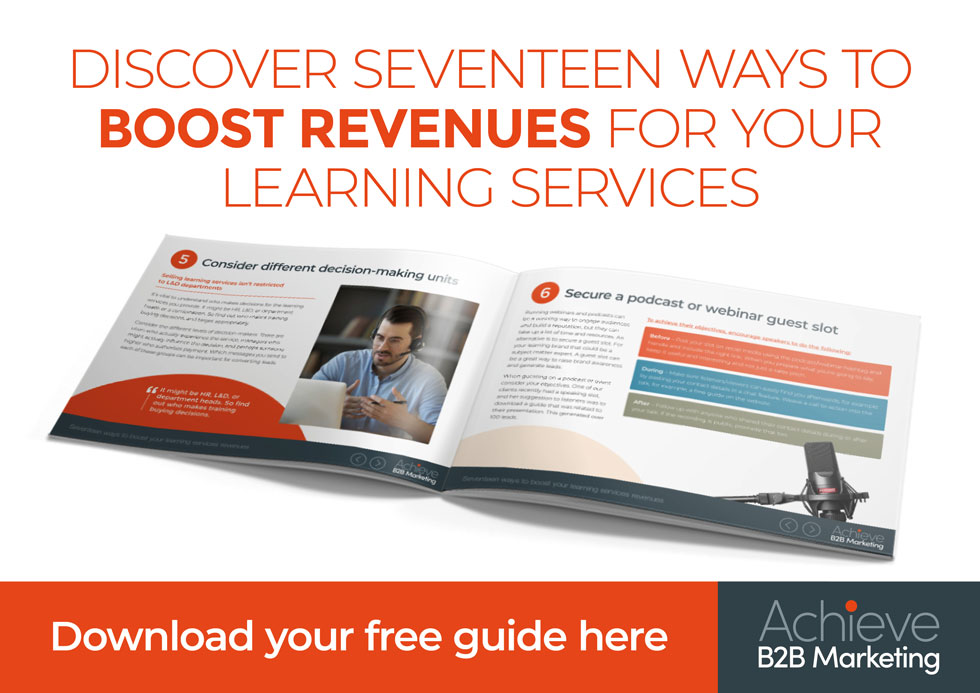 Achieve B2B MD Doug Marshall explains how to create content marketing for training and edtech that will be valued by your buyers.
Achieve B2B MD Doug Marshall explains how to create content marketing for training and edtech that will be valued by your buyers.
Imagine you’re a buyer of learning services or technology. You've got a big decision to make. It could affect your company’s success and your career too.
So well before you speak to anyone in sales you’ll want to do your research. There's probably one thing on your mind: Trust.
If you have commercial responsibilities in a company providing training, digital learning or edtech, your brand and people will need the trust of buyers. So how can your learning brand build trust? A clue lies in this Gartner prediction:
Eighty per cent of B2B sales interactions between suppliers and buyers will occur in digital channels by 2025.
Relevant, informative, and educational content plays an important role in building this trust. Great content marketing can be transformational for brand reputation and lead conversions. I've led marketing strategies for many learning brands, and I've seen how good content marketing builds trust and generates leads.
Here are four considerations when putting together a content marketing programme for training, elearning, and edtech services.
Prepare content marketing for training that your audience will share on social media
Make your content so interesting and insightful that it will be shared on social media, using relevant hashtags and handles.
Your audience is more likely to engage with real people than your corporate social media account. Also, your content will much more likely be shared when it answers customers’ questions. So for both of these reasons involve customer-facing colleagues when choosing subjects. What's going to interest prospects and customers? What will resonate so much they'll want to share with their peers?
Involving colleagues in content marketing will help ensure they share content - so keep colleagues informed of what content is being published with a marketing calendar that you proactively promote. If you're an admin for your LinkedIn page there's a nice feature that enables you to 'Notify Employees' which sends a message to colleagues. So keep in mind both your colleagues, who can post and share your content and customers who will engage with it.
Optimise your content marketing for training
 You’ll want to make sure that your content has a positive impact on your website’s overall SEO. To do this create content using targeted keywords to attract visitors to your website, although be careful not to overuse them as this can be offputting for readers. There are many tools to determine which keywords to target. Here are three which I've found helpful
You’ll want to make sure that your content has a positive impact on your website’s overall SEO. To do this create content using targeted keywords to attract visitors to your website, although be careful not to overuse them as this can be offputting for readers. There are many tools to determine which keywords to target. Here are three which I've found helpful
Semrush features a tool that tells how many searches are made on relevant keywords.
Ask the public collates, tracks and alerts you to the questions being asked on Google.
Moz includes tools to help you identify the difficulty of getting your search term to the top of SERPs.
Consider how you can get valuable inbound links from trusted external websites. One way to do this is to research and identify relevant websites that would feature your content, and in doing so provide a backlink to yours.
Many CMSs have SEO plug-ins to help you optimise pages. I like the Yoast SEO tool for WordPress and Joomla sites that I manage, as it proactively guides me to complete tags. As well as populating meta tags Include a meta description for your page. Although it doesn’t affect Google’s algorithms it will appear in many search results, prompting readers to click through to your content.
Make sure content marketing for learning brands is useful
Create content that will really help your prospect. Ask some customers what content is going to really help them in their job. Don’t restrict yourself to the usual types of content. The most useful content can simply be a checklist. Someone I knew built their lead generation on offering really useful templated contracts. Providing a glossary can be extremely helpful to people new to an industry, (they’re great for SEO too).
Also, consider your customers’ customers. What would your customers like to know about their customers? What invaluable insights could you bring? Surveys of customers’ customers are highly useful. Content about future trends has been shown to be valued by C-suite audiences.
Identify how to make content marketing purposeful
When planning content, consider its purpose. Ask what the end result is. To do this consider the business conversations your company needs to have with prospects to win specific work. This can guide you on the subject, media, channel, and audience that will have the most impact.
 Publish content for each stage of decision-making. Think about what actions you’d like prospects to take and design a CTA around that. Infographics and short videos are going to be more relevant for awareness activity. Webinars and thought leadership documents are likely to be more relevant later once your prospects trust you with their contact details.
Publish content for each stage of decision-making. Think about what actions you’d like prospects to take and design a CTA around that. Infographics and short videos are going to be more relevant for awareness activity. Webinars and thought leadership documents are likely to be more relevant later once your prospects trust you with their contact details.
From writing a blog to editing a video, organising a webinar to creating a guide, content marketing takes time and resources. It’s therefore important to do content marketing well so you get a good return on your time and money.
Remember these key elements of good content marketing - keep it shareable, optimised, useful and purposeful, or SOUP for short. Your colleagues in sales will be thankful that you’ve built trust in your brand and people - and so will that L&D buyer.
If you'd like a free consultation on how to improve content marketing for your learning brand drop us a line or give us a call, we'd love to hear from you!




 Start with your learning and development events objectives
Start with your learning and development events objectives
 What to do during an L&D event
What to do during an L&D event


 Doug Marshall, MD of Achieve B2B Marketing, has judged many marketing awards over the last decade Here he shares his experience and gives you some insights into an award-winning entry's key ingredients.
Doug Marshall, MD of Achieve B2B Marketing, has judged many marketing awards over the last decade Here he shares his experience and gives you some insights into an award-winning entry's key ingredients. nsights? Showing you understood real-world solutions with the research of end-users will help you build a good case.
nsights? Showing you understood real-world solutions with the research of end-users will help you build a good case.

 You’ll want to make sure that your content has a positive impact on your website’s overall SEO. To do this create content using targeted keywords to attract visitors to your website, although be careful not to overuse them as this can be offputting for readers. There are many tools to determine which keywords to target. Here are three which I've found helpful
You’ll want to make sure that your content has a positive impact on your website’s overall SEO. To do this create content using targeted keywords to attract visitors to your website, although be careful not to overuse them as this can be offputting for readers. There are many tools to determine which keywords to target. Here are three which I've found helpful Publish content for each stage of decision-making. Think about what actions you’d like prospects to take and design a CTA around that. Infographics and short videos are going to be more relevant for awareness activity. Webinars and thought leadership documents are likely to be more relevant later once your prospects trust you with their contact details.
Publish content for each stage of decision-making. Think about what actions you’d like prospects to take and design a CTA around that. Infographics and short videos are going to be more relevant for awareness activity. Webinars and thought leadership documents are likely to be more relevant later once your prospects trust you with their contact details.
 ✅ Work with vendors who have a proven track record of helping users. Be sure of the support and training they provide and the quality of online tutorials. That means asking their customers searching questions
✅ Work with vendors who have a proven track record of helping users. Be sure of the support and training they provide and the quality of online tutorials. That means asking their customers searching questions
